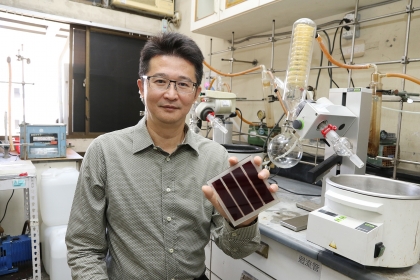NCHU Increases the Power Generation Efficiency of ''Dye-Sensitized Solar Cells'', Published in the Top International Journal
2021-01-20
興新聞張貼者
Unit秘書室
2,345
Professor Chen-Yu Yeh of the Department of Chemistry of National Chung Hsing University implemented the research project of the Ministry of Science and Technology, and formed a research team with Professor Tzu-Chien Wei of the Department of Chemical Engineering of National Tsing Hua University to jointly develop a new generation of "bJS" series of porphyrin dyes, which have been proven to effectively enhance the power generation efficiency of the dye-sensitized solar cells and is a major breakthrough in the research in this field. This achievement was published on line in the top international journal "Angewandte Chemie International Edition" in January 2021. This paper was ranked in the top 5% of the journal's importance and was selected as a very important paper VIP, and a special report was made on ChemistryViews.org (www.ChemistryViews.org), which is highly valued by the international scholars.
Compared with the silicon solar cells that have been generally commercialized, the dye-sensitized solar cells have the advantages of being inexpensive, easy to process, colorful, flexible and suitable for the wearable devices, and the dyes are the core component of the dye-sensitized solar cells. Learning from the structure of natural chlorophyll, the synthetic "YD" series of dyes were published in the journal "Science" in 2011. The use of the porphyrin dyes containing the long carbon chains achieved the efficiency of the dye-sensitized solar cells up to about 12%, which made a world record. The key is that the fence formed by the long carbon chain in the dye blocks the generation of the reverse current.
This time, Professor Yeh and Professor Wei’s team even doubled the number of the long carbon chains in the porphyrin dyes to form a "double-fence" structure. Under the same component assembly conditions, the power generation efficiency is 11.9% higher than the previous high-efficiency "YD" series dyes, proving that its innovative "double fence" structure can effectively improve the power generation efficiency of the dye-sensitized solar cells, showing the great potential of the "bJS" series of the porphyrin dyes.
Professor Chen-Yu Yeh said that in the future when the renewable energy is increasingly important, the "double fence" structure will become one of the effective strategies in the design of dyes in the high-efficiency dye-sensitized solar cells, which is of great development value for the use of solar energy and indoor light sources.
Paper link: https://onlinelibrary.wiley.com/doi/10.1002/anie.202013964
Compared with the silicon solar cells that have been generally commercialized, the dye-sensitized solar cells have the advantages of being inexpensive, easy to process, colorful, flexible and suitable for the wearable devices, and the dyes are the core component of the dye-sensitized solar cells. Learning from the structure of natural chlorophyll, the synthetic "YD" series of dyes were published in the journal "Science" in 2011. The use of the porphyrin dyes containing the long carbon chains achieved the efficiency of the dye-sensitized solar cells up to about 12%, which made a world record. The key is that the fence formed by the long carbon chain in the dye blocks the generation of the reverse current.
This time, Professor Yeh and Professor Wei’s team even doubled the number of the long carbon chains in the porphyrin dyes to form a "double-fence" structure. Under the same component assembly conditions, the power generation efficiency is 11.9% higher than the previous high-efficiency "YD" series dyes, proving that its innovative "double fence" structure can effectively improve the power generation efficiency of the dye-sensitized solar cells, showing the great potential of the "bJS" series of the porphyrin dyes.
Professor Chen-Yu Yeh said that in the future when the renewable energy is increasingly important, the "double fence" structure will become one of the effective strategies in the design of dyes in the high-efficiency dye-sensitized solar cells, which is of great development value for the use of solar energy and indoor light sources.
Paper link: https://onlinelibrary.wiley.com/doi/10.1002/anie.202013964



